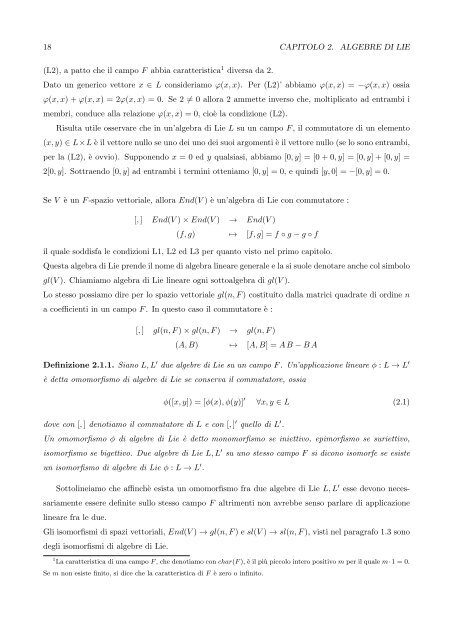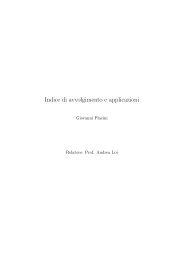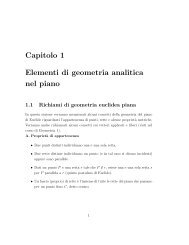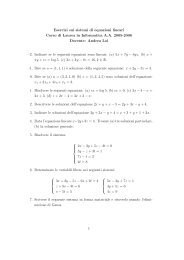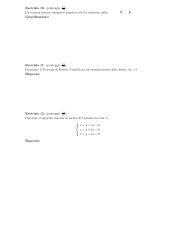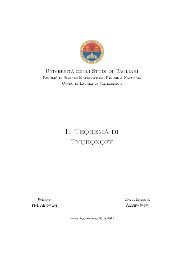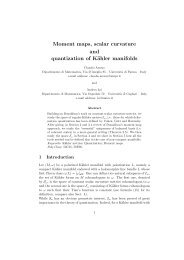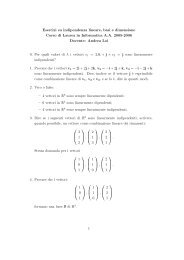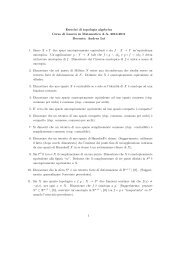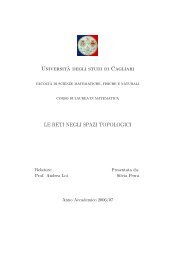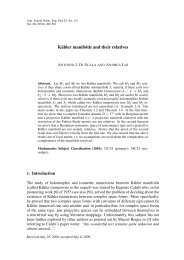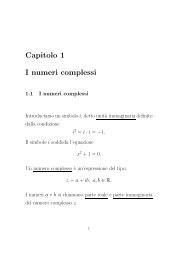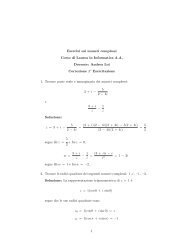Algebre di Lie semisemplici, sistemi di radici e loro classificazione
Algebre di Lie semisemplici, sistemi di radici e loro classificazione
Algebre di Lie semisemplici, sistemi di radici e loro classificazione
Create successful ePaper yourself
Turn your PDF publications into a flip-book with our unique Google optimized e-Paper software.
18 CAPITOLO 2. ALGEBRE DI LIE<br />
(L2), a patto che il campo F abbia caratteristica 1 <strong>di</strong>versa da 2.<br />
Dato un generico vettore x ∈ L consideriamo ϕ(x, x). Per (L2)’ abbiamo ϕ(x, x) = −ϕ(x, x) ossia<br />
ϕ(x, x) + ϕ(x, x) = 2ϕ(x, x) = 0. Se 2 = 0 allora 2 ammette inverso che, moltiplicato ad entrambi i<br />
membri, conduce alla relazione ϕ(x, x) = 0, cioè la con<strong>di</strong>zione (L2).<br />
Risulta utile osservare che in un’algebra <strong>di</strong> <strong>Lie</strong> L su un campo F , il commutatore <strong>di</strong> un elemento<br />
(x, y) ∈ L×L è il vettore nullo se uno dei uno dei suoi argomenti è il vettore nullo (se lo sono entrambi,<br />
per la (L2), è ovvio). Supponendo x = 0 ed y qualsiasi, abbiamo [0, y] = [0 + 0, y] = [0, y] + [0, y] =<br />
2[0, y]. Sottraendo [0, y] ad entrambi i termini otteniamo [0, y] = 0, e quin<strong>di</strong> [y, 0] = −[0, y] = 0.<br />
Se V è un F -spazio vettoriale, allora End(V ) è un’algebra <strong>di</strong> <strong>Lie</strong> con commutatore :<br />
[, ] End(V ) × End(V ) → End(V )<br />
(f, g) ↦→ [f, g] = f ◦ g − g ◦ f<br />
il quale sod<strong>di</strong>sfa le con<strong>di</strong>zioni L1, L2 ed L3 per quanto visto nel primo capitolo.<br />
Questa algebra <strong>di</strong> <strong>Lie</strong> prende il nome <strong>di</strong> algebra lineare generale e la si suole denotare anche col simbolo<br />
gl(V ). Chiamiamo algebra <strong>di</strong> <strong>Lie</strong> lineare ogni sottoalgebra <strong>di</strong> gl(V ).<br />
Lo stesso possiamo <strong>di</strong>re per lo spazio vettoriale gl(n, F ) costituito dalla matrici quadrate <strong>di</strong> or<strong>di</strong>ne n<br />
a coefficienti in un campo F . In questo caso il commutatore è :<br />
[, ] gl(n, F ) × gl(n, F ) → gl(n, F )<br />
(A, B) ↦→ [A, B] = A B − B A<br />
Definizione 2.1.1. Siano L, L ′ due algebre <strong>di</strong> <strong>Lie</strong> su un campo F . Un’applicazione lineare φ : L → L ′<br />
è detta omomorfismo <strong>di</strong> algebre <strong>di</strong> <strong>Lie</strong> se conserva il commutatore, ossia<br />
φ([x, y]) = [φ(x), φ(y)] ′<br />
dove con [, ] denotiamo il commutatore <strong>di</strong> L e con [, ] ′ quello <strong>di</strong> L ′ .<br />
∀x, y ∈ L (2.1)<br />
Un omomorfismo φ <strong>di</strong> algebre <strong>di</strong> <strong>Lie</strong> è detto monomorfismo se iniettivo, epimorfismo se suriettivo,<br />
isomorfismo se bigettivo. Due algebre <strong>di</strong> <strong>Lie</strong> L, L ′ su uno stesso campo F si <strong>di</strong>cono isomorfe se esiste<br />
un isomorfismo <strong>di</strong> algebre <strong>di</strong> <strong>Lie</strong> φ : L → L ′ .<br />
Sottolineiamo che affinchè esista un omomorfismo fra due algebre <strong>di</strong> <strong>Lie</strong> L, L ′ esse devono neces-<br />
sariamente essere definite sullo stesso campo F altrimenti non avrebbe senso parlare <strong>di</strong> applicazione<br />
lineare fra le due.<br />
Gli isomorfismi <strong>di</strong> spazi vettoriali, End(V ) → gl(n, F ) e sl(V ) → sl(n, F ), visti nel paragrafo 1.3 sono<br />
degli isomorfismi <strong>di</strong> algebre <strong>di</strong> <strong>Lie</strong>.<br />
1 La caratteristica <strong>di</strong> una campo F , che denotiamo con char(F ), è il più piccolo intero positivo m per il quale m·1 = 0.<br />
Se m non esiste finito, si <strong>di</strong>ce che la caratteristica <strong>di</strong> F è zero o infinito.


